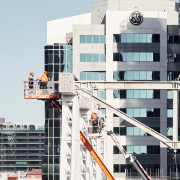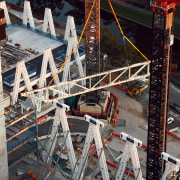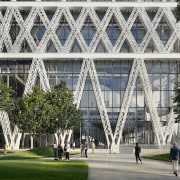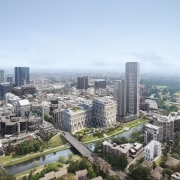A framework for the future
Sporting a dramatic steel exoskeleton, the new landmark museum development Powerhouse Parramatta – by Moreau Kusunoki and Genton – is all about openness and being Net Zero from day one
Designed by Moreau Kusunoki and Genton
From the architects:
The construction of the giant exoskeleton structure for Powerhouse Sydney’s new landmark museum development, Powerhouse Parramatta, is currently underway on site.
Designed by Franco-Japanese architects Moreau Kusunoki (lead designer) and Australian architects Genton (local architect), and constructed by Lendlease, Powerhouse Parramatta is Australia’s largest cultural infrastructure development since the Sydney Opera House and will open in 2025.
The AUD$915 million project is one of the world’s most significant new museum developments and signifies the first state cultural institution built within Sydney’s most dynamic and culturally diverse region, Western Sydney.
Exoskeleton
The defining visual quality of Powerhouse Parramatta is the white steel latticing that surrounds it.
Expressed in three levels of scale and complexity, with the steel members reducing in size and refining as the building rises, this lattice design forms both the building’s façade and, crucially, its supporting structure – its exoskeleton.
The geometry of the lattice structure greatly reduces the amount of material needed to support the building’s physical load.
It also lightens the visual presence of the steel.
Even at ground level, where the lattice columns are at their thickest, they serve to filter light – a filtering that continues all the way up the building and through the interplay between the different geometries.
The exoskeleton is important to the way the building communicates.
Moreau Kusunoki wanted to present a neutral exterior that is open to everyone.
Its white-painted steelwork creates an envelope that expresses the building’s structure very clearly and honestly, emphasising a feeling of accessibility.
The latticed design makes for extreme transparency, so that activity and movement within animates the building from the outside.
This is important to the Powerhouse Parramatta vision which highlights a porous relationship with the surrounding neighbourhood and a culture of welcome and inclusivity.
It also serves as a means of keeping the building’s elements at a human scale.
This is very different from a more conventional steel and concrete structure, which can make a human standing beside them feel fragile.
Here, the smaller steel members, as you rise up the building, can be grasped in the hand.
At the same time, without the need for columns, the interior leaves the spaces and circulation areas free of physical interruptions.
The lattice design emerged out of discussions between Nicolas Moreau, Hiroko Kusunoki and the distinguished Tokyo University professor of engineering, Jun Sato, whose initial sketches were key to defining its geometry. The exoskeleton is being realised with the hands-on expertise of ARUP Engineer Kengo Takamatsu.
It is possible to note a reference to Sydney Harbour Bridge in the lattice structure. The echo was not present in the initial idea, but it is undoubtedly there, with an interesting comparison implicit in the environmental story (see below). The influence of Centre Pompidou, close to Moreau Kusunoki’s Paris office and standing as a ground-breaking model for a museum building with an external structure, is also acknowledged.
Net zero
Opening in 2025, Powerhouse Parramatta will be the greenest public building in Australia, being net-zero from day one of operations.
Powerhouse Parramatta’s sustainability approach is guided by targeting a minimum 6 Star Green Star rating and net zero carbon emissions, achieved by focusing on sustainability in construction and sustainability in operation.
Moreau Kusunoki says the lattice design emerged out of discussions with the distinguished Tokyo University professor of engineering, Jun Sato.
"The geometry of this lattice structure greatly reduces the amount of material needed to support the building’s physical load, as well as lightening the material presence of the steel," he says.
"The design highlights the porous relationship with the surrounding neighbourhood – it also serves as a means of keeping the building’s elements at a human scale.”
Genton principal Steven Toia says the building was conceived as a series of hyper platforms; column-free spaces with flexibility and potential.
"The exoskeleton as a structural system serves the essential requirement of achieving these uninterrupted spaces.”
Powerhouse chief executive Lisa Havilahsays that, architecturally, Powerhouse Parramatta will be one of the great cultural and public buildings of the world.
“It is a project that is redefining and rethinking what museums can and should be for their communities and it’s the first time that a major cultural institution will be located within these diverse and growing communities.
“For me, the most important part of this project is the generational impact of a piece of incredible public architecture igniting the ambition of a community, of a region, of a city, and I’m excited about what precedent it will set at a national and international level.”
Home kitchen bathroom commercial design












